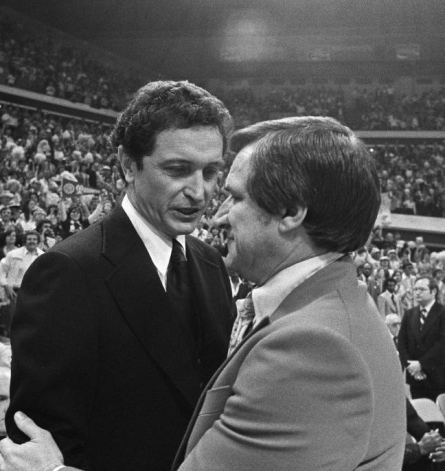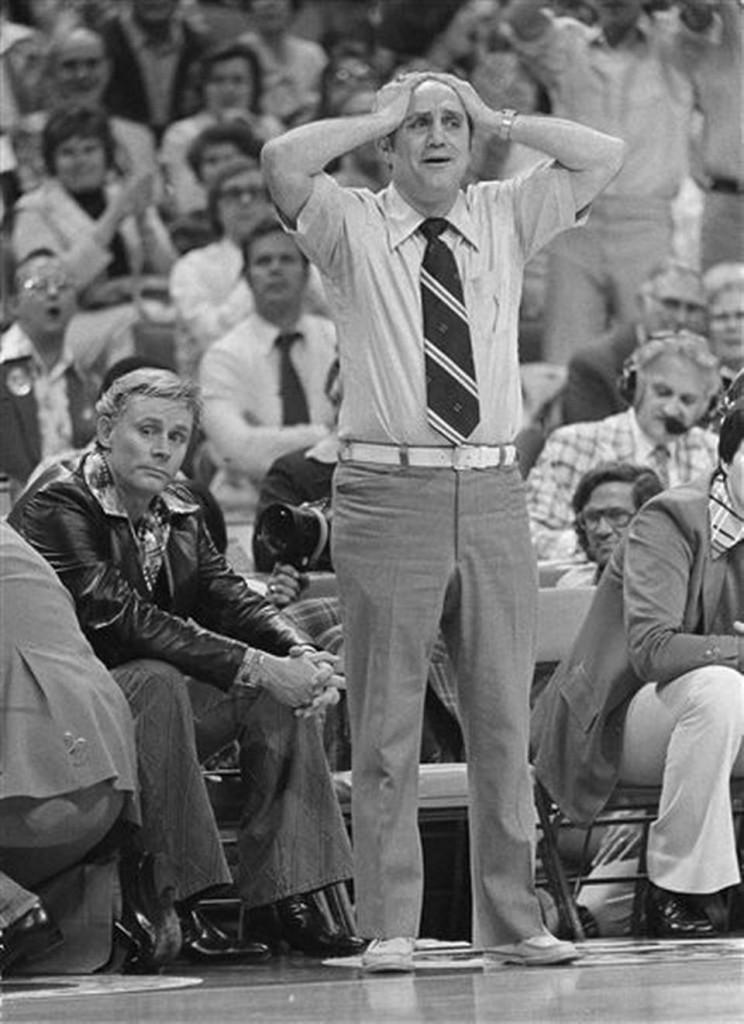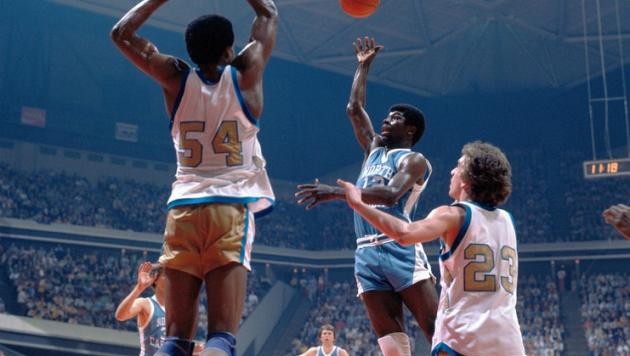It’s one of the many fascinating things we love about sports: Great events, perhaps forgotten due to the relentless march of time, regain their prominence in the eyes of younger generations due to twists in the 24-7 news cycle.
This is how college basketball — like any other sport — continues to be the focus of our passions, the source of many joys, and the creator of memories that bring parents and children and grandparents together.
The college basketball world is still immersed in sadness, following the next-to-each-other deaths of Dean Smith and Jerry Tarkanian. However, Dean’s suffering at the hands of dementia blessedly ended, and Tarkanian was able to live long enough to be enshrined in the Basketball Hall of Fame (in 2013). These were not bad deaths, and that’s more than a little consolation — not enough to make up for the absences of these two figures who shaped college basketball for so many Americans, but something meaningful to cherish amidst the sadness.
One other aspect of Dean’s and Tark’s deaths — or more precisely, their proximity to each other — could enrich College Basketball America: These two passages could enable a nation of younger college basketball fans to realize how special the 1977 Final Four really was.
*
Purely on the surface, the 1977 Final Four in Atlanta’s distinctive arena, The Omni, rates as one of the better “foursomes” in the event’s 76-year history.
Consider this:
One Final Four semifinal involved a controversial finish centered around a disputed buzzer-beating basket and a brief consultation at the scorer’s table:
The other Final Four semifinal was decided by one point, and pitted Dean Smith and Jerry Tarkanian against each other in their only Final Four encounter.
The championship game? Oh, no big deal — it merely gave a beloved coach a national title in the last game of his career.
Setting aside the third-place game (which continued through the 1981 Final Four) between UNLV and UNC-Charlotte, the 1977 Final Four’s three primary showcases produced three thrilling games, two that are easily remembered by historians of the sport. The third game is the one between Dean Smith and Jerry Tarkanian.
Marquette 51, UNCC 49.
Marquette 67, North Carolina 59.
The “less-remembered game” from the 1977 Final Four? North Carolina 84, UNLV 83.
Are you beginning to sense how special this Final Four was?
The really neat thing about this event is that the basketball played in The Omni was only part of the story. This marks a continuing theme with the largest personalities and most important innovators in college basketball (or in any field of endeavor). Such figures matter more than the sum of what they did when they were on the public stage. What they did off the stage mattered, too.
*

Al McGuire and Dean Smith coached not too far from each other in the late 1950s. They developed a strong friendship and met for the national title at the 1977 Final Four.
The 1977 Final Four, while matching Dean and Tark in one semifinal, was ultimately Al McGuire’s Final Four. Yet, the reality of McGuire’s ownership of that weekend in Atlanta magnifies the two giants who joined him on that big stage in The Omni.
McGuire coached at a small North Carolina college named Belmont Abbey — 15 miles from Charlotte — before he moved to Marquette. From 1957 through 1964, McGuire coached not too far away from where Dean Smith began his 36-season head coaching career in Chapel Hill… and had become a North Carolina assistant to Frank McGuire in 1958.
Frank McGuire had in fact coached Al McGuire (no relation) at St. John’s in the late 1940s and early ’50s. When Frank became the head coach at North Carolina in 1952, he brought players from New York to Chapel Hill. When Al McGuire coached at Belmont Abbey, he did the same thing, creating a New York pipeline to the Carolinas — he had, of course, grown up in the Big Apple, just as Frank did.
It is not hard to see how Al McGuire and Dean Smith became friends. They didn’t just work in the same state in the late ’50s and early ’60s. They didn’t really feel beholden to racial pressures or political tensions. Yes, they were somewhat constrained by the forces of the times in which they lived, but they were both colorblind. It also didn’t hurt that Belmont Abbey and North Carolina competed at different levels; it’s not as though Belmont Abbey was a threat to what Smith was trying to rebuild in the first half of the 1960s, before his career took off in 1967.
The colorblindness of McGuire and Smith was matched in later decades by the third coaching giant from the 1977 Final Four. Tarkanian is another example of a man who was undeterred in going to the rougher parts of the recruiting trail to get the players he valued. This is a reason why — for all the ways in which he’s the polar opposite of Dean Smith — he is simultaneously similar to Smith in ways that might have escaped notice over the years.
The coaches from the 1977 Final Four only grow in stature — and interconnectedness — when you contemplate the next statement: Al McGuire is perhaps the most striking example from college basketball history of a person who blended Dean Smith’s and Jerry Tarkanian’s best qualities. He owned the gentle touch of Smith, free of the abrasiveness which marked the darker and more tempestuous side of Tarkanian. Yet, McGuire loved a good show and possessed the street smarts to carry it off, much as Tarkanian did at UNLV. McGuire carried the soul of Smith as a person, but the spirit of a showman which was so evident in Tark the Shark.

This is how Jerry Tarkanian looked when he coached UNLV against Dean Smith and North Carolina in the 1977 Final Four. Tark reveled in storytelling, the theater of competition, and the glitz that surrounded his UNLV program. In this way, he was not too different from Al McGuire, who tirelessly worked to promote Marquette basketball in Milwaukee during the 1970s.
The 1977 Final Four — when it unfolded — was little more than a showcase of very competitive and thrilling college basketball. Today — with the sport remembering two of the coaches from that gathering in Atlanta — the 1977 Final Four can be seen as something greater than it once was: a gathering of three coaches who did so much to carry the story of college basketball into future decades. (The fourth coach, Lee Rose of UNC-Charlotte, was no slouch: He’s merely one of a few men to make Final Fours at two different schools. He earned that place in history when he then led Purdue to the 1980 Final Four in Indianapolis. Gene Keady, his successor, would never get that far.)
What adds to the significance of the 1977 Final Four, however, is that it arrived at a time when college basketball was going through one of its most profound transformations. The sport was in the midst of going from what had been a 25-team event in 1974 (restricted to conference tournament champions in the power leagues) to a 64-team event in 1985. The first seeded NCAA tournament occurred in 1979, and it’s worth noting that McGuire’s Marquette squad was considered a surprising, just-above-the-cut-line at-large participant in the ’77 NCAA Tournament.
In 1979, college basketball received its Great Leap Forward, when Magic and Bird dueled in Salt Lake City and captured the imagination of fans. Just a few years later, in 1982, the era of big-dome basketball arrived for real, as North Carolina and a guy named Jordan — coached by that Dean Smith fellow we’ve been talking about — beat Georgetown and Patrick Ewing in a New Orleans classic.
The 1977 Final Four, as noted above, marked McGuire’s last game as a coach. As much as McGuire did for college hoops as a coach, he probably did more as a broadcaster. When he moved to NBC with Dick Enberg and Billy Packer (calling that 1979 Final Four with Magic and Bird), he made the sport come alive for millions of Americans. The 1977 Final Four didn’t make McGuire any more or less of a genuine original, but it did improve his visibility, and that certainly didn’t hurt the NBC broadcast partnership which lingers in the memory of older fans even now.
It is not, however, for older fans that the 1977 Final Four has been obscured or ignored. It’s for fans in the younger demographic categories… fans who now have reason to give that weekend new life when the story of college basketball is passed down to their children and grandchildren.
*
The 1977 Final Four in The Omni gave college basketball entertaining and dramatic games. It offered historically resonant contests marked at times by controversy, but also by stirring plot twists and down-to-the-wire finishes. Yet, as great as the product was on the court, the 1977 Final Four endures because of the three men who became larger-than-life figures after that trip to Atlanta had ended.
The 1966 (Texas Western) Final Four is more historically resonant for its off-the-court effects on all of college basketball.
The 1983 and 1985 Final Fours are more instantly memorable because of the upsets they created.
Now, however, there’s fresh reason to view the 1977 Final Four as one of the more magical and meaningful mountaintop moments in the history of college basketball. Only time will tell if this particular event gains an added degree of historical traction among future generations of college basketball fans.
Here’s hoping it will.

